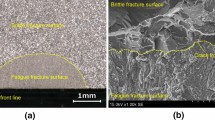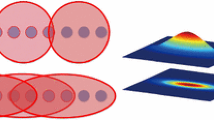Abstract
An efficient crack growth model using a total Lagrangian smoothed particle hydrodynamics based on the conservation of momentum, deformation gradient, and the asymmetric kernel is proposed to improve the flexibility of fatigue crack growth simulations. A set of particles are used to represent the physical domain. The crack region is modeled by eliminating the interaction between two particles that cross the crack line. The crack growth direction is determined by the maximum principal stress, in which the particle that has the maximum principal stress will lose its interactions with the neighbor particles. The proposed method’s performance is tested by the fatigue crack growth problem, in which the crack growth direction and stress intensity factor show a good agreement with the references. It is found that the method is efficient for the crack propagation problem, which does not require particle update and any special treatment at the crack tips when the crack propagate.



















Similar content being viewed by others
References
Andrade HC, Leonel ED (2019) The multiple fatigue crack propagation modelling in nonhomogeneous structures using the DBEM. Eng Anal Bound Elem. https://doi.org/10.1016/j.enganabound.2018.10.026
Bonet J, Lok TSL (1998) Variational and momentum preservation aspects of smooth particle hydrodynamic formulations. Comput Methods Appl Mech Eng. https://doi.org/10.1016/S0045-7825(99)00051-1
Chen JK, Beraun JE (2000) A generalized smoothed particle hydrodynamics method for nonlinear dynamic problems. Comput Methods Appl Mech Eng. https://doi.org/10.1016/S0045-7825(99)00422-3
Dirgantara T, Aliabadi MH (2000) Crack Growth analysis of plates loaded by bending and tension using dual boundary element method. Int J Fract. https://doi.org/10.1023/A:1007696111995
Dolbow J, Moes N, Belytschko T (2000) Modeling fracture in Mindlin–Reissner plates with the extended finite element method. Int J Solids Struct. https://doi.org/10.1016/S0020-7683(00)00194-3
Eslamian A, Khayat M (2017) Numerical studies to propose a ghost particle removed SPH (GR-SPH) method. Appl Math Model. https://doi.org/10.1016/j.apm.2016.09.026
Fedelinski P, Aliabadi MH, Rooke DP (1993) The dual boundary element method in dynamic fracture mechanics. Eng Anal Bound Elem. https://doi.org/10.1016/0955-7997(93)90016-E
Gingold RA, Monaghan JJ (1997) Smoothed particle hydrodynamics: theory and application to non-spherical stars. Mon Not R Astron Soc. https://doi.org/10.1093/mnras/181.3.375
Grellier TD, Jones BD, Pramanik R, Pan K, Albaiz A, Williams JR (2016) Mixed-mode fracture modeling with smoothed particle hydrodynamics. Comput Geotech. https://doi.org/10.1016/j.compgeo.2016.06.002
Hillerborg A, Modeer M, Petersson PE (1976) Analysis of crack formation and crack growth in concrete by means of fracture mechanics and finite elements. Cem Concr Res. https://doi.org/10.1016/0008-8846(76)90007-7
Johnson GR, Stryk RA, Beissel SR (1996) SPH for high velocity impact computations. Comput Methods Appl Mech Eng. https://doi.org/10.1016/S0045-7825(96)01089-4
Lee CH, Gil AJ, Ghavamian A, Bonet J (2019) A Total Lagrangian upwind Smooth Particle Hydrodynamics algorithm for large strain explicit solid dynamics. Methods Appl Mech Eng Comput. https://doi.org/10.1016/j.cma.2018.09.033
Lee CH, Gil AJ, Greto G, Kulasegaram S, Bonet J (2016) A new Jameson–Schmidt–Turkel Smooth Particle Hydrodynamics algorithm for large strain explicit fast dynamics. Methods Appl Mech Eng Comput. https://doi.org/10.1016/j.cma.2016.07.033
Lee CH, Gil AJ, Hassan OI, Bonet J, Kulasegaram S (2017) A variationally consistent Streamline Upwind Petrov Galerkin Smooth Particle Hydrodynamics algorithm for large strain solid dynamics. Methods Appl Mech Eng Comput. https://doi.org/10.1016/j.cma.2017.02.002
Libersky LD, Petschek AG, Carney TC, Hipp JR, Allahdadi FA (1993) High strain Lagrangian hydrodynamics: a three-dimensional SPH code for dynamic material response. J Comput Phys. https://doi.org/10.1006/jcph.1993.1199
Lin J, Li J, Guan Y, Zhao G, Naceur H, Coutellier D (2018) Geometrically nonlinear bending analysis of functionally graded beam with variable thickness by a meshless method. Compos Struct. https://doi.org/10.1016/j.compstruct.2018.01.063
Lin J, Naceur H, Coutellier D, Laksimi A (2014) Efficient meshless SPH method for the numerical modeling of thick shell structures undergoing large deformations. Int J Nonlinear Mech. https://doi.org/10.1016/j.ijnonlinmec.2014.04.009
Lin J, Naceur H, Coutellier D, Laksimi A (2014) Geometrically nonlinear analysis of thin-walled structures using efficient shell-based SPH method. Comput Mater Sci. https://doi.org/10.1016/j.commatsci.2013.12.010
Lin J, Naceur H, Coutellier D, Laksimi A (2015) Geometrically nonlinear analysis of two-dimensional structures using an improved smoothed particle hydrodynamics method. Int J Comput Aided Eng Softw. https://doi.org/10.1108/EC-12-2013-0306
Liu YJ, Li YX, Xie W (2017) Modeling of multiple crack propagation in 2-D elastic solids by the fast multipole boundary element method. Eng Fract Mech. https://doi.org/10.1016/j.engfracmech.201701010
Lucy LB (1997) A numerical approach to the testing of the fission hypothesis. Astron J. https://doi.org/10.1086/112164
Mao Z, Liu GR, Dong X (2017) A comprehensive study on the parameters setting in smoothed particle hydrodynamics (SPH) method applied to hydrodynamics problems. Comput Geotech. https://doi.org/10.1016/j.compgeo.2017.07.024
Moes N, Dolbow J, Belytschko T (1999) A finite element method for crack growth without remeshing. Int J Numer Method Eng. https://doi.org/10. 1002/(SICI)1097-0207(19990910)46:1<131::AID-NME726>3.0.CO;2-J
Ming FR, Zhang AM, Wang SP (2015) Smoothed particle hydrodynamics for the linear and nonlinear analyses of elastoplastic damage and fracture of shell. Int J Appl Mech. https://doi.org/10.1142/S1758825115500325
Monaghan JJ (1994) Simulating free surface flows with SPH. J Comput Phys. https://doi.org/10.1006/jcph.1994.1034
Monaghan JJ (2000) SPH without a tensile instability. J Comput Phys. https://doi.org/10.1006/jcph.1994.1034
Murakami Y et al (eds) (1987) Stress intensity factors handbook. Pergamon Press, London
Naceur H, Lin J, Coutellier D, Laksimi A (2015) Efficient smoothed particle hydrodynamics method for the analysis of planar structures undergoing geometric nonlinearities. J Mech Sci Technol. https://doi.org/10.1007/s12206-015-0232-9
Oliveira TAA, Gomes G, Evangelista F (2019) Multiscale aircraft fuselage fatigue analysis by the dual boundary element method. Eng Anal Bound Elem. https://doi.org/10.1016/j.enganabound.2019.03.032
Pisa CD, Aliabadi MH (2013) Fatigue crack growth analysis of assembled plate structures with dual boundary element method. Eng Fract Mech. https://doi.org/10.1016/j.engfracmech.2012.09.032
Portela A, Aliabadi MH, Rooke DP (1992) The dual boundary element method: effective implementation for crack problems. Int J Numer Methods Eng. https://doi.org/10.1002/nme.1620330611
Portela A, Aliabadi MH, Rooke DP (1993) Dual boundary element incremental analysis of crack propagation. Comput Struct. https://doi.org/10.1016/0045-7949(93)90189-K
Potyondy DO, Wawrzynek PA, Ingraffea AR (1995) Discrete crack growth analysis methodology for through cracks in pressurized fuselage structures. Int J Numer Methods Eng. https://doi.org/10.1002/nme.1620381003
Randles PW, Libersky LD (1996) Smoothed particle hydrodynamics: some recent improvements and applications. Comput Methods Appl Mech Eng. https://doi.org/10.1016/S0045-7825(96)01090-0
Santana E, Portela A (2016) Dual boundary element analysis of fatigue crack growth, interaction and linkup. Eng Anal Bound Elem. https://doi.org/10.1016/j.enganabound.2015.12.002
Silva ALL, Correia JAFO, Jesus AMP, Lesiuk G, Fernandes AA, Calcada R, Berto F (2019) Influence of fillet end geometry on fatigue behaviour of welded joints. Int J Fatigue. https://doi.org/10.1016/j.ijfatigue.2019.02.025
Silva ALL, Jesus AMP, Xavier J, Correia JAFO, Fernandes AA (2017) Combined analytical–numerical methodologies for the evaluation of mixed-mode (I + II) fatigue crack growth rates in structural steels. Eng Fract Mech. https://doi.org/10.1016/j.engfracmech.2017.04.016
Stellingwerf RF, Wingate CA (1993) Impact modelling with smooth particle hydrodynamics. Int J Impact Eng. https://doi.org/10.1016/0734-743X(93)90065-F
Tada H, Paris PC, Irwin GR (2000) The stress analysis of cracks handbook, 3rd edn. ASME Press, London
Tazoe K, Tanaka H, Oka M, Yagawa G (2020) Analyses of fatigue crack propagation with smoothed particle hydrodynamics method. Eng Fract Mech. https://doi.org/10.1016/j.engfracmech.2019.106819
Vidal Y, Bonet J, Huerta A (2007) Stabilized updated Lagrangian corrected SPH for explicit dynamic problems. Int J Numer Methods Eng. https://doi.org/10.1002/nme.1859
Acknowledgements
The authors gratefully acknowledge the Research, Community Service, and Innovation Program (P3MI) 2020, Institut Teknologi Bandung, Indonesia, for the support funding of this research.
Author information
Authors and Affiliations
Corresponding author
Ethics declarations
Conflict of interest
The authors state that there is no conflict of interest.
Additional information
Publisher's Note
Springer Nature remains neutral with regard to jurisdictional claims in published maps and institutional affiliations.
Rights and permissions
About this article
Cite this article
Wiragunarsa, I.M., Zuhal, L.R., Dirgantara, T. et al. A particle interaction-based crack model using an improved smoothed particle hydrodynamics for fatigue crack growth simulations. Int J Fract 229, 229–244 (2021). https://doi.org/10.1007/s10704-021-00553-8
Received:
Accepted:
Published:
Issue Date:
DOI: https://doi.org/10.1007/s10704-021-00553-8




